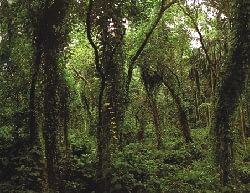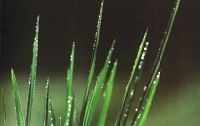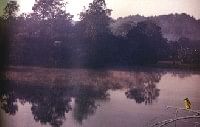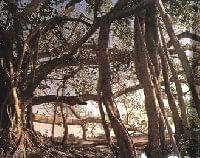|
Capturing
Natural Treasures
Aasha
Mehreen Amin
 The
warmth of Bangladesh's countryside is undeniable. It is
where in spite of the vulgar attacks of urbanisation and
human encroachment, there are still spots where nature rules
and flaunts its richness. Nature has always been the bread
and butter of poetry. Jibanananda Das in particular, was
obsessed with the irresistible beauty of Bengal's natural
landscape. His verses capture the vibrancy, colour and tranquility
of the lush greenery of Bangladesh interspersed with glimmering
and abundant rivers. His poetry also brings in human faces,
characters like Suranjana, Arunima Sanyal and Banalata Sen.
All this is visually represented through Dr. Noazesh Ahmed's
latest book Dhanshiri Noditir Pashe (On the Banks of the
Dhanshiri). As with his other project Chhinnapatra, which
gave visual expression to Tagore's famous poem, here Ahmed
recreates Jibanananda's world with his remarkable photography.
The Dhanshiri River recurs in these pictures as it is a
river that has always been close to Jibanananda's heart.
But as poet Shamsur Rahman in his foreword to the book points
out "The Dhanshiri River Jibanananda wrote about is
now almost dead. It is difficult to predict how long the
river will continue to flow." Which makes Noazesh's
images of the river and its adorning banks, all the more
invaluable. The
warmth of Bangladesh's countryside is undeniable. It is
where in spite of the vulgar attacks of urbanisation and
human encroachment, there are still spots where nature rules
and flaunts its richness. Nature has always been the bread
and butter of poetry. Jibanananda Das in particular, was
obsessed with the irresistible beauty of Bengal's natural
landscape. His verses capture the vibrancy, colour and tranquility
of the lush greenery of Bangladesh interspersed with glimmering
and abundant rivers. His poetry also brings in human faces,
characters like Suranjana, Arunima Sanyal and Banalata Sen.
All this is visually represented through Dr. Noazesh Ahmed's
latest book Dhanshiri Noditir Pashe (On the Banks of the
Dhanshiri). As with his other project Chhinnapatra, which
gave visual expression to Tagore's famous poem, here Ahmed
recreates Jibanananda's world with his remarkable photography.
The Dhanshiri River recurs in these pictures as it is a
river that has always been close to Jibanananda's heart.
But as poet Shamsur Rahman in his foreword to the book points
out "The Dhanshiri River Jibanananda wrote about is
now almost dead. It is difficult to predict how long the
river will continue to flow." Which makes Noazesh's
images of the river and its adorning banks, all the more
invaluable.
 As
is usual with Noazesh's photography, the images evoke a
number of emotions. There is nostalgia in the way the dry
leaves are scattered over some unknown path in the forest
or the horizontal lines of a shimmering golden river at
sunset. There is awe at the delicate threads of a silky
spider web attaching itself on red blossoms or the diamond
dew drops on emerald stalks of grass. Sunbeams fall on golden
paddy fields and saffron light colours the late afternoon
scenes. Each picture is followed by Jibanananda's poetry
with English translations by Dr Fakrul Alam. As
is usual with Noazesh's photography, the images evoke a
number of emotions. There is nostalgia in the way the dry
leaves are scattered over some unknown path in the forest
or the horizontal lines of a shimmering golden river at
sunset. There is awe at the delicate threads of a silky
spider web attaching itself on red blossoms or the diamond
dew drops on emerald stalks of grass. Sunbeams fall on golden
paddy fields and saffron light colours the late afternoon
scenes. Each picture is followed by Jibanananda's poetry
with English translations by Dr Fakrul Alam.
 True
to his tradition, Noazesh has filled this book with the
most glorious imagery of natural Bangladesh. Perfect shades
of green and orange of newly cut harvests, meandering blue
water against carpets of green, diaphanous wings of a dragonfly
decorating blades of grass give proof of the exquisite work
of the greatest artist of all--our Creator. From time to
time as you turn the pages there comes a classic, stylised
scene of country landscape and a woman's face or form no
doubt to depict Bonolata Sen. Whether this adds or disturbs
the pureness of the scene is of course up to the viewer
to decide. True
to his tradition, Noazesh has filled this book with the
most glorious imagery of natural Bangladesh. Perfect shades
of green and orange of newly cut harvests, meandering blue
water against carpets of green, diaphanous wings of a dragonfly
decorating blades of grass give proof of the exquisite work
of the greatest artist of all--our Creator. From time to
time as you turn the pages there comes a classic, stylised
scene of country landscape and a woman's face or form no
doubt to depict Bonolata Sen. Whether this adds or disturbs
the pureness of the scene is of course up to the viewer
to decide.
 Speaking
of purity, a slightly jarring aspect of some of the pictures
is the superimposing of other imagery. While this manipulation
has been performed for effect, to enhance the visual representation
of the poetry, many times it seems unnecessary to mar such
gorgeous photography with clever graphics. Speaking
of purity, a slightly jarring aspect of some of the pictures
is the superimposing of other imagery. While this manipulation
has been performed for effect, to enhance the visual representation
of the poetry, many times it seems unnecessary to mar such
gorgeous photography with clever graphics.
Nevertheless,
the richness of Noazesh's seasoned photography with his
keen eye for detail gives the viewer a sheer sense of thrill
of the treasures that still live in this country and that
need to be painstakingly preserved.

Dr
Noazesh Ahmed, a plant scientist, has always been interested
in literature and photography. Formerly a research scientist
specialising in tea technology, he has worked as a United
Nations FAO adviser in various Southeast Asian Countries.
Dr Ahmed is also a photographer recognised internationally
and has exhibited his work in the US, Europe, Japan and
India. His other photo-albums include Bangladesh (1975),
Portrait of Bangladesh (1982), Quest for Reality (1997),
Wild Flowers of Bangladesh (1998) and Chinnapatra (2002).
|

 The
warmth of Bangladesh's countryside is undeniable. It is
where in spite of the vulgar attacks of urbanisation and
human encroachment, there are still spots where nature rules
and flaunts its richness. Nature has always been the bread
and butter of poetry. Jibanananda Das in particular, was
obsessed with the irresistible beauty of Bengal's natural
landscape. His verses capture the vibrancy, colour and tranquility
of the lush greenery of Bangladesh interspersed with glimmering
and abundant rivers. His poetry also brings in human faces,
characters like Suranjana, Arunima Sanyal and Banalata Sen.
All this is visually represented through Dr. Noazesh Ahmed's
latest book Dhanshiri Noditir Pashe (On the Banks of the
Dhanshiri). As with his other project Chhinnapatra, which
gave visual expression to Tagore's famous poem, here Ahmed
recreates Jibanananda's world with his remarkable photography.
The Dhanshiri River recurs in these pictures as it is a
river that has always been close to Jibanananda's heart.
But as poet Shamsur Rahman in his foreword to the book points
out "The Dhanshiri River Jibanananda wrote about is
now almost dead. It is difficult to predict how long the
river will continue to flow." Which makes Noazesh's
images of the river and its adorning banks, all the more
invaluable.
The
warmth of Bangladesh's countryside is undeniable. It is
where in spite of the vulgar attacks of urbanisation and
human encroachment, there are still spots where nature rules
and flaunts its richness. Nature has always been the bread
and butter of poetry. Jibanananda Das in particular, was
obsessed with the irresistible beauty of Bengal's natural
landscape. His verses capture the vibrancy, colour and tranquility
of the lush greenery of Bangladesh interspersed with glimmering
and abundant rivers. His poetry also brings in human faces,
characters like Suranjana, Arunima Sanyal and Banalata Sen.
All this is visually represented through Dr. Noazesh Ahmed's
latest book Dhanshiri Noditir Pashe (On the Banks of the
Dhanshiri). As with his other project Chhinnapatra, which
gave visual expression to Tagore's famous poem, here Ahmed
recreates Jibanananda's world with his remarkable photography.
The Dhanshiri River recurs in these pictures as it is a
river that has always been close to Jibanananda's heart.
But as poet Shamsur Rahman in his foreword to the book points
out "The Dhanshiri River Jibanananda wrote about is
now almost dead. It is difficult to predict how long the
river will continue to flow." Which makes Noazesh's
images of the river and its adorning banks, all the more
invaluable. As
is usual with Noazesh's photography, the images evoke a
number of emotions. There is nostalgia in the way the dry
leaves are scattered over some unknown path in the forest
or the horizontal lines of a shimmering golden river at
sunset. There is awe at the delicate threads of a silky
spider web attaching itself on red blossoms or the diamond
dew drops on emerald stalks of grass. Sunbeams fall on golden
paddy fields and saffron light colours the late afternoon
scenes. Each picture is followed by Jibanananda's poetry
with English translations by Dr Fakrul Alam.
As
is usual with Noazesh's photography, the images evoke a
number of emotions. There is nostalgia in the way the dry
leaves are scattered over some unknown path in the forest
or the horizontal lines of a shimmering golden river at
sunset. There is awe at the delicate threads of a silky
spider web attaching itself on red blossoms or the diamond
dew drops on emerald stalks of grass. Sunbeams fall on golden
paddy fields and saffron light colours the late afternoon
scenes. Each picture is followed by Jibanananda's poetry
with English translations by Dr Fakrul Alam.  True
to his tradition, Noazesh has filled this book with the
most glorious imagery of natural Bangladesh. Perfect shades
of green and orange of newly cut harvests, meandering blue
water against carpets of green, diaphanous wings of a dragonfly
decorating blades of grass give proof of the exquisite work
of the greatest artist of all--our Creator. From time to
time as you turn the pages there comes a classic, stylised
scene of country landscape and a woman's face or form no
doubt to depict Bonolata Sen. Whether this adds or disturbs
the pureness of the scene is of course up to the viewer
to decide.
True
to his tradition, Noazesh has filled this book with the
most glorious imagery of natural Bangladesh. Perfect shades
of green and orange of newly cut harvests, meandering blue
water against carpets of green, diaphanous wings of a dragonfly
decorating blades of grass give proof of the exquisite work
of the greatest artist of all--our Creator. From time to
time as you turn the pages there comes a classic, stylised
scene of country landscape and a woman's face or form no
doubt to depict Bonolata Sen. Whether this adds or disturbs
the pureness of the scene is of course up to the viewer
to decide. Speaking
of purity, a slightly jarring aspect of some of the pictures
is the superimposing of other imagery. While this manipulation
has been performed for effect, to enhance the visual representation
of the poetry, many times it seems unnecessary to mar such
gorgeous photography with clever graphics.
Speaking
of purity, a slightly jarring aspect of some of the pictures
is the superimposing of other imagery. While this manipulation
has been performed for effect, to enhance the visual representation
of the poetry, many times it seems unnecessary to mar such
gorgeous photography with clever graphics. 